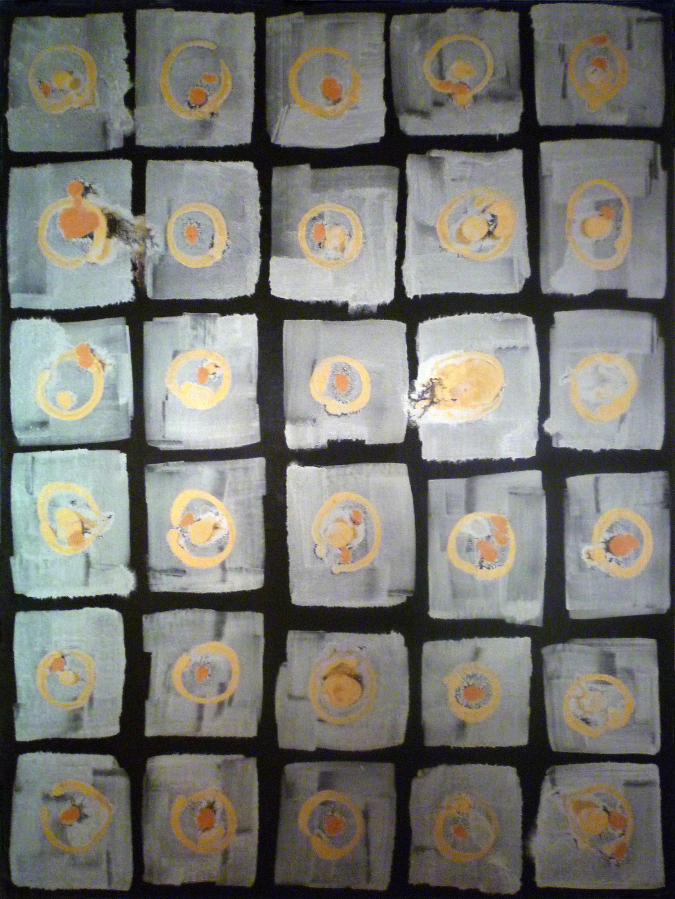Resist reading the titles of the paintings on this page. Just take them in. Think what you think, feel what you feel, wonder what you wonder.
Then, check out the names and see how they reshape, enrich — or even limit — your experience.
Painter Karen Folgarelli said she has toyed with titling her abstract works versus leaving viewers with “no references” at all. She has also written whole poems instead of titles, she said.
“People want explanations, and you have to think about whether you want to give them,” she said. “Or if there even are explanations that can be put into words.”
If You Go
• What: “Contemporary Abstract Painting — Exploring the Unknown” with Karen Folgarelli.
• When: Opening reception 5-9 p.m. June 3. Artist talk 4-6 p.m. June 11.
• Where: Angst Gallery, 1015 Main St.
• On the Web: angstgallery.com
• Download the latest “hotsheet” for theFirst Friday Art Walk.
Folgarelli loves picking up her paints and getting into “the zone” where time stops and space doesn’t matter, she said. Her work “holds mysteries where the inner and outer senses merge. It is visual poetry,” she wrote in a statement about her show that opens today at the Angst Gallery, 1015 Main St.
“Contemporary Abstract Paintings — Exploring the Unknown” is the title of the show, which will be up at Angst all month. And “exploring” is a good word for Folgarelli, a relative newcomer here, who said she has spent the past year delving into the beauty of the Pacific Northwest as well as her own inner worlds.
Process
Folgarelli, a California native, went to San Jose State University and studied design and illustration. She moved to Los Angeles and then to Kansas City, Mo., where she worked for Hallmark Cards, the premiere maker of sentimental rectangles. At first her job was editorial, working with artists and writers to make sure words and images matched up in picture-perfection; eventually she worked as a photo stylist — scouting locations, decorating scenes, finding props and models. She occasionally “rented a cat,” she said. “I loved that job.”
But she also realized that she was doing somebody else’s art, expressing somebody else’s emotions. So she took a workshop in what’s called “process painting” — an approach that de-emphasizes your final product and anybody’s reaction to it, and instead focuses on your own journey of creation. The overall idea is to boost creativity and reduce inhibitions, with no worries about mastering techniques or enduring critiques.
Some very accomplished artists are drawn to “process art” because it helps them get back in touch with core feelings and raw creativity, Folgarelli said; others are beginners who “can’t even draw stick figures” and really don’t care — they just want to enjoy the experience and see where it goes.
“It’s all for the sake of expression. Some people would get into a very meditative state,” Folgarelli said. “It’s like art therapy.”
For Folgarelli, a successful and commercial illustrator and designer, that kind of silent-but-deep artistic reaching led away from representation and toward abstraction.
‘What about this?’
Abstract art can be many different things, but its underlying thrust is loosening or discarding any rules about representing “reality.” Abstract art can distort, exaggerate, evade or totally ignore what’s “real”; it can emphasize color, pattern and mood over anything recognizable; it can delve into dreams and nightmares, mysteries and symbols; ultimately it can be “art for art’s sake,” challenging the very idea of what art is supposed to be — or that it’s supposed to be anything in particular.
Classic examples of abstract art include Jackson Pollack’s massive and chaotic splashes and squiggles; Pablo Picasso’s kaleidoscopic human figures; Wassily Kandinsky’s architectural intersections of sharp lines and shapes; “Three Flags,” stacked like a pyramid, by Jasper Johns; and even featureless fields of solid color by Mark Rothko.
You can view these in their historical contexts and consider how they challenged viewers of their times; you can also look inward and simply let moods, ideas, feelings wash over you. There’s no right way to look at abstract art. Perhaps the only wrong way is to assume that, especially if it seems simple, it’s just not “artistic” enough.
A too-common reaction: “That’s not art! I could have done it!”
But you didn’t, said Leah Jackson, owner and curator of the Angst Gallery. The artist did.
Jackson said she loves listening to people’s candid reactions to abstraction. One time, she said, a little girl walked by the gallery’s front window with her parents and stood agog at the abstract smorgasbord inside. “I told you scribbling was art!” she told her parents. “She was so happy,” Jackson said.
Is scribbling art? Maybe, Jackson said. Abstract art questions the nature of art, but doesn’t answer. “It pushes the perspective,” Folgarelli said. “It says, ‘What about this?’ ”
New life
Like her children, Folgarelli has graduated to a whole new life recently.
Her son and daughter both left Kansas City to attend college in Oregon, one in Salem and one in Portland. Folgarelli followed them but gratefully noted that scholarships have mostly liberated her from scrambling to pay tuition bills. She’s been able to devote herself to art since she moved to east Vancouver about a year ago.
She has developed a line of elaborate greeting cards with angel imagery. She’s been working hard at refining her paintings. And, she has spent lots of time photographing a lush landscape that couldn’t be more different from the Midwest, she said.
“I love the river,” she said of Vancouver’s boundary to the south. “I didn’t know that I would fall in love with it like this.”




